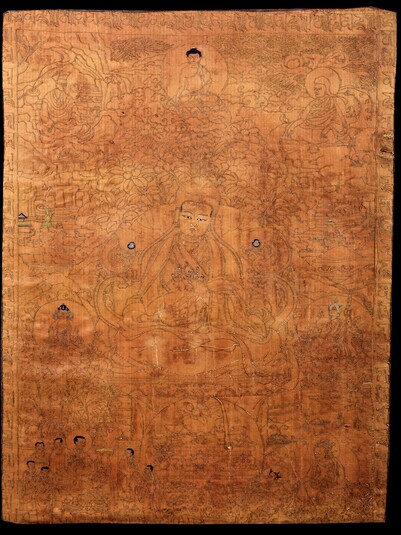
Item: Teacher (Lama)
| Origin Location | Tibet |
|---|---|
| Date Range | 1700 - 1799 |
| Lineages | Sakya and Buddhist |
| Material | Ground: Silk |
| Collection | Rubin Museum of Art |
Classification: Person
Lama: wearing monastic robes and a Sakya style pandita hat he performs the mudra (gesture) of Dharma teaching with both hands placed at the heart with the fingers splayed in imitation of the spokes of a wheel. The lower body is wrapped with a meditation cloak and he sits atop an ornate cushioned throne with a decorative backrest. Two small tables in front support a begging bowl, teacup and long-life vase and the like.
At the top center is Shakyamuni Buddha. At the left, seated at the entrance to a retreat cave is a Drigung Kagyu lama. At the right a lama wearing monastic robes and a pandita hat sits with the hands extended across the knees. At the middle left is Amitayus the Buddha of Long-life and at the right side the Indian teacher Padmasambhava. At the bottom left is an unidentified taecher, likely to be the commissioner of the artwork. Numerous attendant figures surround the lama. At the bottom right corner is the wealth deity Yellow Jambhala holding a bijapuraka fruit and a mongoose.
The border of the painting is filled with letters written in the decorative 'lantza' script.
Jeff Watt 4-2000
Front of Painting
English Translation of Inscription: Ranjana four syllable inscription repeated around the border of the textile.
Collection of Caroline & Wesley Halpert
Tradition: Sakya Teachers
Painting Type: Gold Ground
Textile: Embroidered Artwork Main Page
Teacher: Unidentified
Collection of Rubin Museum of Art: Textile Page
Textile: Main Page
Textile: Masterworks (纺织品, འཐག་དྲུབ་མ།)
Collection of RMA: Textile Masterworks
Tradition: Sakya, Lineage Teacher Painting Masterworks (Rubin Museum)
